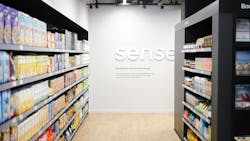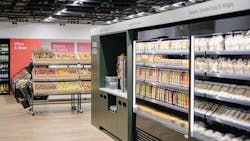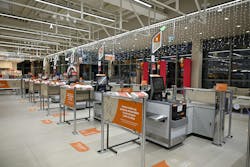From Scan & Go to Just Walk Out: The Supermarket That Might Crack Automated Grocery Shopping
Having worked as a grocery cashier before modern scanning technology and being a frequent Walmart shopper, I've always been interested in innovations that might speed up the checkout process. I became a self-checkout enthusiast years ago, finding it faster than waiting for cashiers in addition to modern checkout lanes not making it easy for the customer to help with bagging. Despite my efficiency, Walmart trips still took at least an hour, so I was intrigued when I heard about "Scan & Go" programs. After trying Walmart's version for two months, I abandoned it due to several frustrations: the $14 monthly fee, having to use my own phone instead of store-provided scanners, the app's poor scanning capabilities, and random security checks that confused employees. In the end, using "Scan & Go" actually increased my time in the store rather than reducing it.
This experience made me curious about Amazon's more ambitious approach to frictionless shopping. While Walmart required customers to do the scanning work themselves, Amazon's "Just Walk Out" grocery stores promised a truly automated experience: Walk in, take what you need, and leave without any scanning or checkout process at all. No muss, no fuss.
Despite the innovation, Amazon recently abandoned its "Just Walk Out" model for several reasons:
- The technology implementation costs proved unsustainable.
- Rather than the advertised AI automation, the system relied on a team of 1,000 workers in India reviewing footage to ensure accuracy.
- With only 52 stores across 8 states, the tech was only available at half of the e-commerce giant's Amazon Fresh stores.
- Many consumers expressed discomfort with the extensive tracking required.
Instead, Amazon has opted for the "Scan & Go" model, switching to what it refers to as "Dash Carts" requiring customers to still be involved in the checkout process.
This retreat might suggest automated grocery shopping was just a passing trend, but the industry continues to push forward with new approaches.
At NRF 2025: Retail's Big Show this January, Sensei, a European provider of autonomous retail tech, unveiled its vision for autonomous supermarkets that aims to address previous shortcomings with its motto of "Retail that feels right and runs better". Their system offers:
- Real-time Virtual Basket Technology: Similar to Amazon's concept, but with claimed improvements in accuracy and transparency. No scanning, no checkout lines.
- Staff Redeployment: Only bringing in employees when needed for a customer so they can contribute to higher-value roles like bakery and deli operations.
- Smart Ecosystem Integration: Seamlessly connecting automated systems like coffee machines
- Guaranteed Privacy: Its tech is GDPR-compliant, ensuring cameras don't collect or store biometric data points.
"Sensei's technology goes beyond eliminating checkout lines—it enhances the entire shopping journey while providing retailers with invaluable real-time data to optimize their operations," explains Vasco Portugal, CEO and Co-Founder of Sensei.
What sets Sensei apart is its proprietary AI technology that combines computer vision, machine learning, and advanced sensors. These elements work together to achieve a 99% accuracy in tracking product interactions, according to the company. Sensei states that the system maintains transparency by displaying purchases in real time, eliminating both scanning and checkout lines.
For retailers, the company promises:
- Labor-light operations with real-time shelf inventory visibility, enabling proactive replenishment and theft elimination.
- In-store insights that optimize management and monetize performance metrics externally.
- Stores are open for longer, with or without staff, and wherever works best for retailers to unlock new revenue opportunities.
Sensei has already launched a 1,200+ square-meter autonomous supermarket in Portugal with MC (Sonae Group), featuring:
- Democratic Entry: No app, card, or registration required—open like any traditional supermarket.
- Comprehensive Product Selection: Including weighable produce, fish counter service, and bulk bakery items.
- Frictionless Checkout: Items automatically appear on screen for confirmation without unpacking.
- Smart Discrepancy Detection: The system can identify differences between what was picked up versus what was weighed.
The company also has a vision of not just supermarkets, but small convenience stores like that in airports, hospitals, schools, workplaces, etc.
Is Sensei's vision truly groundbreaking? Not in concept but potentially in execution. Success hinges on several factors:
- Technology Performance: Will the 99% accuracy claim hold up in daily operation?
- Cost Structure: Even Walmart charges $14 monthly for its partial automation service, though Sensei is promising no apps or subscriptions are needed. It could mean higher grocery prices to pay for the tech.
- Consumer Value Proposition: Amazon's stores lack competitive pricing and widespread accessibility.
For automated grocery shopping to finally break through, the technology must work flawlessly while offering genuine consumer benefits beyond novelty. Sensei's approach shows promise, but like many retail innovations before it, the proof will be in practical implementation across different markets and store formats.
For now, most of us can only read about these innovations—wondering if they'll eventually transform our local shopping experience or join the long list of retail experiments that never quite reached their potential.
About the Author
Laura Davis
Editor-in-Chief, New Equipment Digest
Laura Davis is the editor in chief of New Equipment Digest (NED), a brand part of the Manufacturing Group at EndeavorB2B. NED covers all products, equipment, solutions, and technology related to the broad scope of manufacturing, from mops and buckets to robots and automation. Laura has been a manufacturing product writer for eight years, knowledgeable about the ins and outs of the industry, along with what readers are looking for when wanting to learn about the latest products on the market.


